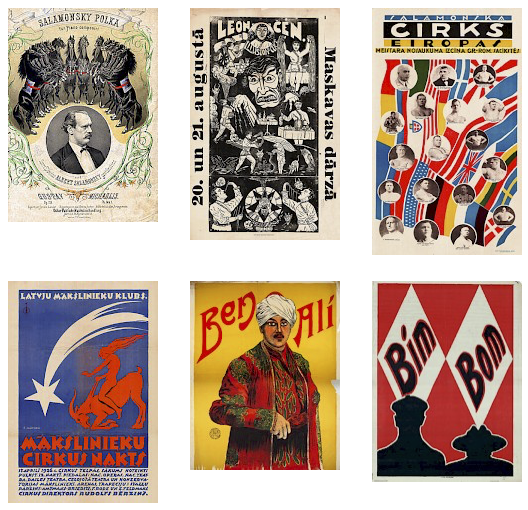Circus in Latvia
The first circus tours reached the territory of Latvia in the early 19th century. Around 1864, a temporary wooden circus building was erected opposite Vērmane’s Garden where performances of touring circuses were staged during the summer season. Among the performers were the juggler Karl Rappo from Austria-Hungary, the acrobat and equestrian Christoph de Bach, who was born in the Duchy of Courland, and his Circus Gymnasticus, as well as many others. Around 1878, Albert Salamonsky, a businessman, circus artist and horse trainer, who wanted to build a circus building in Riga, came to Riga from Prussia. The building of Salamonsky Circus in Riga was designed by the Latvian architect Jānis Frīdrihs Baumanis. It was completed in 1888.
The new circus building could accommodate up to 1,700 spectators and it was the first building intended for mass entertainment in Riga, which was also used for other performances: choir concerts, cinema shows and public functions. The first local professional performers: wrestlers, conjurors, cyclists, wild animal trainers, etc. started gathering in the new circus building. During the first Republic of Latvia, there were few Latvian artists performing at the Riga Circus. Local artists who could not stage their shows in the Riga Circus, travelled all across Latvia and in summers they performed in tents set up on market squares, which also used to be called balagans.
With the outbreak of WWII, when the Soviet Army occupied Latvia, Salamonsky Circus was nationalized. Between 1944 and 1990, the work of circus artists, like in other circuses of the USSR, was governed by the Circus Department of the USSR Ministry of Culture. Several circus studios, e.g. “Jaunība” (“Youth”) (1981), also started taking on students.
For a long time, the traditional circus with trained animals was the only circus genre in Latvia. In the 1970s, a new circus genre was developing in France, and later on all across Europe and in other continents, which initially was known as the new circus and then as the contemporary or modern circus.
There are no animals in the contemporary circus and all shows have a certain message.
In December 2016, the Ministry of Culture recognized the importance of continuing and developing circus arts in Latvia and the need for changes to enable further functioning of the Riga Circus as it must become a multifunctional and contemporary venue for performances of circus arts, music, dance and other interdisciplinary shows. Furthermore, circus arts education and residencies programmes should be developed. It was also announced that it was necessary to renovate the historic building of the Riga Circus at Merķeļa iela 4 and to establish such a model of circus operation which would fully use the potential of the building as regards circus and other performing arts during the renovation works.
Māra Pāvula
“Source: the entry “Circus in Latvia”, National Encyclopaedia, scheduled for publication in 2018”

